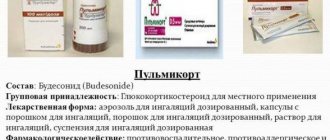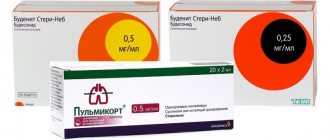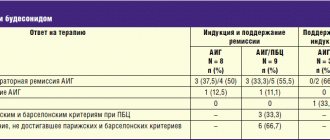Pharmacological properties of the drug Pulmicort
budesonide (INN - budesonidum - budesonide) is a corticosteroid that has a pronounced local anti-inflammatory effect. The affinity of budesonide for GCS receptors is approximately 15 times higher than that of prednisolone. The anti-inflammatory effect causes a decrease in bronchial obstruction both at the early and late stages of the allergic reaction. Budesonide reduces the activity of histamine and methacholine. Absorption. After inhaled administration, budesonide is rapidly absorbed. The maximum plasma concentration is reached within 60 minutes after the start of nebulization and is approximately 4 nmol/l after a dose of 2 mg. In adults, pulmonary distribution of nebulized budesonide is approximately 15% of the nominal dose. Systemic availability via a jet nebulizer is also approximately 15% of the nominal dose, a small portion of which is due to absorption of the drug that has been ingested. Distribution and metabolism. Plasma protein binding is approximately 90%. The volume of distribution is approximately 3 l/kg. Budesonide undergoes significant (≈90%) first-pass metabolism in the liver to metabolites with low GCS activity. The GCS activity of the main metabolites, 6β-hydroxybudesonide and 16α-hydroxyprednisolone, is ≤1% of the activity of budesonide. Removal . Budesonide is eliminated by metabolism catalyzed primarily by the CYP3A4 enzyme. Metabolites are excreted in the urine in unchanged or conjugated form. Only a small amount of unchanged budesonide is detected in the urine. Budesonide has a high systemic clearance (approximately 1.2 l/min), its plasma half-life after intravenous administration averages 4 hours. The pharmacokinetic parameters of budesonide are dose proportional at clinically significant doses. Children. In children aged 4-6 years with asthma, the maximum plasma concentration is reached within 20 minutes after the start of nebulization and is approximately 2.4 nmol/l after taking a dose of 1 mg. In patients with asthma aged 4-6 years, the pulmonary distribution of budesonide administered by nebulizer is 6% of the nominal dose, and the systemic availability of budesonide after inhalation with a jet nebulizer (Pari LC Jet Plus with Pari Master compressor) is approximately 6% of the nominal dose. In children aged 4 to 6 years with asthma, the systemic clearance of budesonide is approximately 0.5 l/min. In children (per 1 kg of body weight), the clearance is approximately 50% higher than the clearance in adults. In children with asthma, the terminal half-life of budesonide after inhalation is about 2 hours, as in healthy adults. The maximum concentration and AUC following a single dose of 1 mg nebulized budesonide in children aged 4 to 6 years are comparable to those in healthy adults receiving the same dose of budesonide using the same nebulization system. The pharmacokinetics of budesonide in patients with impaired renal function is not known. The effect of budesonide may be increased in patients with liver disease.
Overdose
In case of acute overdose, no clinical manifestations occur. If the overdose is chronic, the effects of hypercortisolism , as well as suppression of adrenal function.
In addition, clinical manifestations of hypercortisolism may be observed: arterial hypertension , muscle weakness, weight gain, amenorrhea , hyperpigmentation . Also, in case of chronic overdose for the treatment of hypercortisolism, the drug is gradually discontinued, systematically reducing the dosage.
Use of the drug Pulmicort
Dosing is individual. If the daily dose does not exceed 1 mg, the entire dose can be administered simultaneously. If a higher daily dose is required, it should be divided into 2 doses per day. The initial dose is: in children over 6 months of age : 0.25–0.5 mg/day. If necessary, the dose can be increased to 1 mg/day; in adults : 1–2 mg/day. For maintenance treatment: in children over 6 months of age : 0.25–2 mg/day; in adults : 0.5–4 mg/day. In severe cases, the dose can be increased. Dosage table
Dose (mg) | Volume of Pulmicort (suspension for inhalation) | |
0.25 mg/ml | 0.5 mg/ml | |
| 0,25 | 1 ml* | – |
| 0,5 | 2 ml | – |
| 0,75 | 3 ml | – |
| 1 | 4 ml | 2 ml |
| 1,5 | – | 3 ml |
| 2 | – | 4 ml |
*It is necessary to increase the volume to 2 ml using 0.9% saline solution or aerosol solution (Pulmicort suspension for inhalation can be mixed with sodium chloride solution 9 mg/ml (0.9%) and/or aerosol solutions containing terbutaline, salbutamol, fenoterol, acetylcysteine, cromoglycic acid or ipratropium bromide.
The mixture should be used within 30 minutes). After using a single dose, the effect occurs within a few hours. The full therapeutic effect is achieved only after several weeks of treatment. The maintenance dose should be as low as possible. Patients using oral steroids When replacing therapy with oral steroids, the patient should be in a relatively stable condition. For 10 days, Pulmicort suspension is used in a high dose in combination with the dose of an oral steroid that was used previously. Thereafter, the oral dose should be gradually reduced to the maximum possible level, for example by 2.5 mg of prednisolone or equivalent per month. Often, the use of an oral steroid can be stopped completely. Because budesonide enters the lungs through inhalation, it is important that the patient inhales the drug slowly and evenly through the nebulizer nozzle. There is no experience in treating patients with impaired hepatic and renal function. Since budesonide is eliminated primarily by hepatic metabolism, caution is required when used in patients with severe liver cirrhosis. Children who cannot inhale the drug through the nozzle can use a breathing mask. Using Pulmicort using a nebulizer Pulmicort is inhaled using a jet nebulizer with a nozzle or an appropriate breathing mask. Ultrasonic nebulizers should not be used because they provide a very low dose of budesonide to the patient. The nebulizer and compressor (propellant) should be adjusted so that most of the supplied liquid droplets are within 3–5 microns. in vitro study showed that the Pari Inhalierboy, Pari Master and Ailos nebulizers provided comparable doses of budesonide. The amount of budesonide delivered to the patient varies between 11-22% of the nebulizer dose and depends on factors such as: nebulization time; filling volume; technical characteristics of the compressor (propellant) and nebulizer; the volume of air that the patient inhales; use of a breathing mask or nozzle. The speed of air flow through the nebulizer also matters. To obtain the maximum possible dose of budesonide, the flow rate should be 5–8 L/min. The filling volume should be 2–4 ml. The available dose for small children is maximized by using a breathing mask that fits tightly to the face.
Effective combinations
The instructions for the medicine note that this drug is very effective in combination with other medications (whether mucolytics, antihistamines or mast cell membrane stabilizers). Many people are interested in how to dilute Pulmicort with saline solution.
According to reviews, inhalations with this drug may be more effective if the drug is used for more than a month. Suspensions with the product can be combined with inhalations with Berodual. The fact is that against the background of such combined use, shortness of breath is very well relieved.
Side effects of the drug Pulmicort
The number of local side effects that were noted in patients using the drug is up to 10%.
Common (1/100) | Airways | Candidal infection of the mouth and throat, mild throat irritation, cough, hoarseness |
Single (≤1/1000) | Are common | Angioedema |
CNS | Nervousness, anxiety, depression, behavior disorder | |
Leather | Urticaria, rashes, dermatitis, subcutaneous hemorrhages | |
Airways | Bronchospasm |
When using inhaled corticosteroids, in order to minimize the risk of candidal infections of the oropharynx, the patient should rinse his mouth with water after each procedure. In isolated cases, signs or symptoms of systemic glucocorticoid effects, including adrenal hypofunction, may appear. Facial skin irritation has been reported in some cases where a breathing mask has been used. To prevent irritation, you should wash your face after using the mask.
Instructions
This medicine is available in the form of turbuhaler and suspensions - Pulmicort nebulas are actively used for laryngitis in children for inhalation in a nebulizer. A mask and mouthpiece are required. This is necessary for the child to take deep breaths, so that the medication can be evenly distributed in the respiratory system.
It is important to find out in advance how to dilute Pulmicort with saline for children.
According to experts, the medication is excellent for the treatment of chronic respiratory pathologies in children, while at the same time being a very effective prophylactic agent. Upon completion of inhalation of Pulmicort (any of its release formats), you should rinse your mouth as thoroughly as possible with boiled water in order to prevent the occurrence of oropharyngeal candidiasis.
Cleaning the nebulizer after inhalation should be done after every second use. Thus, the device needs to be thoroughly dried and washed, and the mask and mouthpiece need to be treated after each use.
What are the proportions of Pulmicort and saline solution for a child? First, let's find out the dosage of the drug.
Special instructions for the use of the drug Pulmicort
When using inhaled steroids, patients should rinse their mouths with water after each dose, as there is a risk of infection of the oropharynx with fungal microflora. Concomitant treatment with ketoconazole, itraconazole or other strong CYP3A4 inhibitors should be avoided. If cancellation is not possible, the interval between the use of these drugs should be increased as much as possible. Special monitoring is required in patients who have used oral steroids, since the risk of developing adrenal insufficiency may persist over a long period of time. Patients who require acute treatment with high-dose corticosteroids or long-term treatment with inhaled corticosteroids at the highest recommended doses may also be considered at risk. These patients may develop signs and symptoms of adrenal insufficiency when under extreme stress. During periods of stress or planned surgical interventions in this group of patients, the possibility of using additional systemic corticosteroids should be considered. When switching from oral steroid therapy to inhaled corticosteroids, patients may experience symptoms such as muscle and joint pain. In such cases, a temporary increase in the dose of the oral steroid may be possible. In isolated cases, symptoms such as fatigue, headache, nausea, vomiting are noted, indicating systemic insufficiency of GCS. Replacing systemic steroid therapy with inhaled corticosteroids sometimes results in allergic manifestations such as rhinitis and eczema, which were previously controlled by systemic medications. In children and adolescents receiving long-term treatment with corticosteroids, regular growth monitoring is recommended, regardless of the form of the drug used. The benefits of GCS therapy should be considered in comparison with the possible risk of growth inhibition. As with other types of inhaled therapy, paradoxical bronchospasm may occur immediately after dosing. If severe reactions occur, treatment should be reconsidered and alternative therapy initiated if necessary. Patients should be advised to contact their physician if the effect of treatment decreases, as repeated inhalations to control severe asthma attacks should not delay the start of other important therapy. In case of sudden deterioration of the patient's condition, therapy must be supplemented with a course of short-acting oral steroids. Decreased liver function may affect the ability to eliminate budesonide. When using Pulmicort in children over 3 years of age at doses up to 400 mcg/day, no systemic effects were observed. Within the dose range of 400–800 mcg/day, biochemical signs of a systemic effect may occur. At daily doses exceeding 800 mcg, such signs are common. The asthma disease itself, as well as the use of inhaled corticosteroids, can slow down the patient’s growth. However, studies of children and adolescents treated with budesonide for an extended period of time (≤13 years) have shown that these patients achieve expected adult height. During pregnancy and breastfeeding. Data obtained from a study of approximately 2000 women during pregnancy did not reveal an increased risk of developmental disorders that would result from budesonide therapy. Results from animal studies have demonstrated that corticosteroids may cause developmental disorders, however, these data are not considered significant in humans at recommended doses. During pregnancy, it is necessary to use the least effective dose of budesonide, taking into account the risk of worsening the course of asthma. It is not known whether budesonide passes into breast milk. The use of budesonide during breastfeeding should only be considered if the expected benefit to the mother outweighs any likely risk to the baby. The drug does not affect the ability to drive vehicles or operate other machinery.
Compound
Glucocorticosteroid drugs are the main therapy for bronchial asthma, laryngospasm and bronchospasm, as well as croup in children. With the development of bronchial obstruction or pneumonia, inpatient treatment is required using intramuscular or intravenous injections, and sometimes intravenous drip medications. The active ingredient of the drug is budesonide.
Additional substances are:
- sodium chloride;
- sodium citrate;
- disodium edetate;
- anhydrous citric acid;
- polysorbate 80;
- water for injections.
Interactions of the drug Pulmicort
There are no data on clinically significant cases of interaction of inhaled corticosteroids with drugs used for asthma. Ketoconazole at a dose of 200 mg 1 time per day increases the plasma concentration of oral budesonide (3 mg 1 time per day) by an average of 6 times when taken simultaneously. When ketoconazole was administered 12 hours after budesonide, the concentration of the latter in the blood plasma increased by an average of 3 times. There is no information about such an interaction regarding inhaled budesonide, however, in this case, a significant increase in its level in the blood plasma is expected. Since there are no data to make dosage recommendations, combinations of these drugs should be avoided. If this is not possible, the interval between the use of ketoconazole and budesonide should be increased if possible. The possibility of reducing the dose of budesonide should also be considered. Other potent CYP3A4 inhibitors, such as itraconazole, also lead to significant increases in budesonide plasma levels.
Antibiotic or not?
Budesonide is not an antibiotic and it does not have antibacterial capabilities. But this drug can be prescribed as an additional therapy during antibiotic treatment.
There is evidence indicating an increased risk of developing pneumonia during the treatment of patients with chronic obstructive bronchial diseases. Research is being conducted in this area to clarify the mechanism of development of pneumonia during treatment with Pulmicort. One of the claims is that budesonide relieves inflammation, and the clinical picture of the disease is smoothed out. Also, often in patients with COPD, pneumonia can be perceived in the initial stages as another exacerbation of the underlying disease.
Therefore, the prescription of Pulmicort does not exclude the joint prescription of an antibiotic, since in case of bacterial inflammation it is not effective enough on its own.
Storage conditions for the drug Pulmicort
At temperatures below 30 °C. Keep closed using the protective cap. An open container should be used within 12 hours. After opening the envelope, the containers it contains should be used within 3 months. Always store unopened containers in an envelope to protect them from light. If only 1 ml was used, the remainder is not sterile. Single-dose packages should be stored in an upright position to protect the suspension from settling. The 0.25 and 0.5 mg/mL dose packs have a line indicating the 1 mL level when the single-dose packs are held upside down.
List of pharmacies where you can buy Pulmicort:
- Moscow
- Saint Petersburg
Use of suspensions
The active ingredient that is part of Pulmicort is, as noted earlier, budesonide. 2 milliliters of a suspension of this medication contains one dose of the active ingredient, which can be 250 or 500 micrograms of the hormonal agent. The activity of budesonide, which is contained in the nebulas of the drug, is fifteen times higher compared to Prednisolone.
The instructions for the nebulas indicate that to prepare suspensions for laryngotracheitis in children for inhalation, you will need ingredients in the form of Pulmicort nebulas along with terbutaline solution, saline, fenoterol, salbutamol and acetylcysteine. All ingredients are mixed, and an inhalation suspension for children based on the drug is obtained. It can be used no later than half an hour after preparation.
Reviews
According to reviews from pediatricians, the medicine should not be prescribed to children suffering from severe kidney damage, and also to infants under six months of age, as well as to patients with high sensitivity to the active ingredient, that is, budesonide. With great caution, an inhalation solution with Pulmicort is prescribed to patients with tuberculosis, liver cirrhosis and fungal diseases.
This medicine is used exclusively locally in the form of inhalations. Immediately before use, Pulmicort is recommended to be diluted in saline solution.



